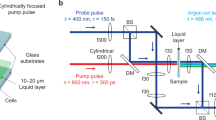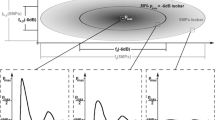Abstract
Purpose. To determine the dependence of the permeabilzation of the plasma membrane on the characteristics of laser-generated stress waves.
Methods. Laser pulses can generate stress waves by ablation. Depending on the laser wavelength, fluence, and target material, stress waves of different characteristics (rise time, peak stress) can be generated. Human red blood cells were subjected to stress waves and the permeability changes were measured by uptake of extracellular dye molecules.
Results. A fast rise time (high stress gradient) of the stress wave was required for the permeabilization of the plasma membrane. While the membrane was permeable, the cells could rapidly uptake molecules from the surrounding medium by diffusion.
Conclusions. Stress waves provide a potentially powerful tool for drug delivery.
Similar content being viewed by others
REFERENCES
K. S. Suslick (ed). Ultrasound: Its chemical, physical and biological effects. VCH, New York, 1988.
A. J. Coleman and J. E. Saunders. A review of the physical properties and biological effects of the high amplitude acoustic fields used in extracorporeal lithotripsy. Ultrasonics 31:75–89 (1993).
A. G. Doukas and T. J. Flotte. Physical characteristics and biological effects of laser-induced stress waves. Ultrasound Med. Biol. 22:151–164 (1996).
M. W. Morton, D. L. Miller, and A. A. Brayman. A review of in vitro bioeffects of inertial ultrasonic cavitation from a mechanistic perspective. Ultrasound Med. Biol. 22:1131–1154 (1996).
R. P. Holmes, L. I. Yeaman, R. G. Taylor, and D. L. McCullogh. Altered neutrophil permeability following shock wave exposure in vitro. J. Urol. 147:733–737 (1992).
A. G. Doukas, D. J. McAuliffe, and T. J. Flotte. Biological effects of laser-induced shock waves: Structural and functional cell damage in vitro. Ultasound Med. Biol. 19:137–146 (1993).
J. Liu, T. N. Lewis, and M. R. Prausnitz. Non-invasive assessment and control of ultrasound-mediated membrane permeabilization. Pharm. Res. 15:918–924 (1998).
S. Gambilher, M. Delius, and J. W. Ellwart. Transient increase in membrane permeability of L1210 cells upon exposure to lithotripter shock waves in vitro. J. Membr. Biol. 141:267–275 (1994).
S. Lee, T. Anderson, H. Zhang, T. J. Flotte, and A. G. Doukas. Alteration of cell membrane by stress waves in vitro. Ultrasound Med. Biol. 22:1285–1293 (1996).
H. J. Kim, J. F. Greenleaf, R. R. Kinnick, J. T. Bronk, and M. E. Bolander. Ultrasound-mediated transfection of mammalian cells. Human Gene Therapy 7:1339–1346 (1996).
D. J. McAuliffe, S. Lee, T. J. Flotte, and A. G. Doukas. Stresswave-assisted transport through the plasma membrane in vitro. Lasers Surg. Med. 20:216–222 (1997).
S. Bao, B. D. Thrall, and D. Miller. Transfection of a reporter plasmid into cultured cells by sonoporation in vitro. Ultrasound Med. Biol. 23:953–959 (1997).
J. A. Wyber, J. Andrews, and A. D'Emanuele. The use of sonication for the efficient delivery of plasmid DNA into cells. Pharm. Res. 14:750–756 (1997).
A. G. Doukas, D. J. McAuliffe, S. Lee, V. Venugopalan, and T. J. Flotte. Physical factors involved in stress-wave-induced cell injury. The effect of stress gradient. Ultrasound Med. Biol. 21:961–967 (1995).
S. Lee, D. J. McAuliffe, H. Zhang, Z. Xu, J. Taitelbaum, T. J. Flotte, and A. G. Doukas. Stress-wave-induced membrane permeation of red blood cells is facilitated by aquaporins. Ultrasound Med. Biol. 23:1089–1094 (1997).
M. Tonetti and A. De Flora. Carrier erythrocytes clinical pharmacokinetic considerations. Clin. Pharmacokinet. 25:351–357 (1993).
D. A. Hutchins. Ultrasonic generation by pulsed lasers. Physical Acoustics 18:21–123 (1988).
C. R. Phipps, Jr., T. P. Turner, R. F. Harrison, G. W. York, W. Z. Osborne, G. K. Anderson, X. F. Corlis, L. C. Haynes, H. S. Steele, K. C. Spicochi, and T. R. King. Impulse coupling targets in vacuum by KrF, HF, and CO2 single pulse laser. J. Appl. Phys. 64:1083–1096 (1988).
A. D. Zweig, V. Venugopalan, and T. F. Deutsch. Stress generated in polyimide by excimer-laser radiation. J. Appl. Phys. 74:4181–4188 (1993).
R. Srinivasan. Ablation of polymers and biological tissue by ultraviolet lasers. Science 234:559–565 (1986).
A. N. Perri. Theory of momentum transfer to a surface with a high-power laser. Phys. Fluids 16:1435–1440 (1973).
T. J. Flotte, T. Anderson, D. J. McAuliffe, T. Hasan, and A. G. Doukas. Laser-induced enhancement of cytotoxicity: A new approach to cancer therapy. In Laser-tissue Interactions IV, S. L. Jacques, (ed), Proceedings SPIE, 1882:122–129, The international Society for Optical Engineering, Bellingham, WA, 1993.
M. Delius. Minimal static excess pressure minimizes the effect of extracorporeal shock waves on cells and reduces it on gallstones. Ultrasound Med. Biol. 23:611–617 (1997).
P. L. Blackshear and G. L. Blackshear. Mechanical hemolysis, In Handbook of Bioengineering. R. Skalak, and S. Chien (eds), McGraw-Hill Book Company, New York, 1976, pp. 15.1–15.19.
L. B. Everett, J. D. Hellums, C. P. Alfrey, and E. C. Lynch. Red blood cell damage by shear stresses. Biophys. J. 12:257–273 (1972).
S. Lee, D. J. McAuliffe, T. J. Flotte, N. Kollias, and A. G. Doukas. Photomechanical transcutaneous molecular delivery. J. Invest. Dermatol. 111:925–929 (1998).
K. Teshima, T. Ohshima, S. Tanaba, and T. Nagai. Biomechanical effects of shock waves on Escherichia coli and λphage DNA. Shock Waves 4:293–297 (1995)
T. Kodama, H. Venohara, and K. Takayama. Innovative technology for tissue disruption by explosive-induced shock waves. Ultrasound Med. Biol. 24:1459–1466 (1998).
Author information
Authors and Affiliations
Corresponding author
Rights and permissions
About this article
Cite this article
Mulholland, S.E., Lee, S., McAuliffe, D.J. et al. Cell Loading with Laser-Generated Stress Waves: The Role of the Stress Gradient. Pharm Res 16, 514–518 (1999). https://doi.org/10.1023/A:1018814911497
Issue Date:
DOI: https://doi.org/10.1023/A:1018814911497




